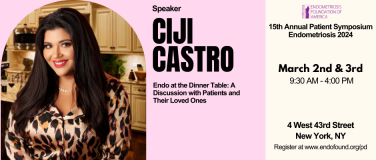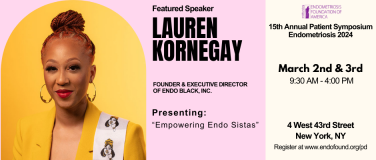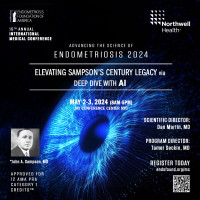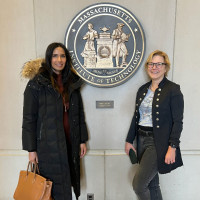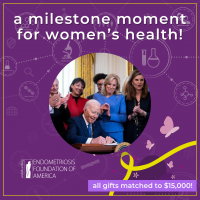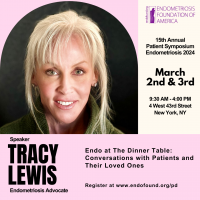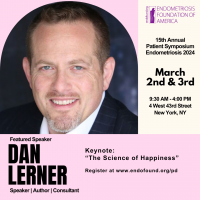
Sophia Tarasenko had never heard of endometriosis until she read an article about it in Science News magazine 16 months ago. Since then, she’s conducted scientific research on it, has made it the topic of her entry in a regional science fair competition, and is leading the charge to add it to her high school’s health curriculum.
Tarasenko, a 16-year-old junior at Jericho High School on Long Island, is absorbed in learning about endometriosis. What’s unusual about her interest at such a young age is that she doesn’t have the disease, nor was she aware of anyone who had it when she first learned about it.
“I was reading in that article about how it takes seven to 10 years to get diagnosed and one in 10 women have it, and I thought, ‘How do I not know about this condition?’” she said. “I continued reading up on it, watched some TikTok videos to get the social media aspect, and now I’m immersed in it.”
Tarasenko was a sophomore in Jericho’s science research program last school year. Hoping to find a mentor and get real-world experience when the year ended, she emailed 30 endometriosis researchers to see if one would allow her to work in their lab over the summer.
“I was ghosted by most of them, which was understandable since I was a high school student,” Tarasenko said. “But Dr. Metz responded and invited me to join her lab to work with her and MD/PhD student Stephanie Busch.”
Dr. Christine Metz is an investigator at the Feinstein Institutes for Medical Research and co-director of the ROSE (Research OutSmarts Endometriosis) study, which EndoFound sponsors. The ROSE study’s goals are to reduce the time it takes to be diagnosed with endometriosis, develop noninvasive methods to diagnose it, discover better treatments, understand the genetic basis of the disease, and alleviate pain and suffering among patients.
Tarasenko said her experience there ranged from the basic, like learning how to work in a lab, to the more complex, such as studying the effects of calcitriol on endometrial stromal cells.
“I loved it,” she said. “I made a few mistakes along the way, but I got a lot better as I learned.”
When Tarasenko returned to her school’s research program as a junior this past fall, she had to present her summer work to a panel of teachers, who chose the best presentations to compete in the Long Island Science and Engineering Fair. She made it past the first round three weeks ago and will present in the second round in March. The winners from that will advance to the international competition.
Tarasenko said that even though the judges were scientifically well-versed, not all were familiar with endometriosis.
“Some of them didn’t know much about it, so I had to explain what it is, the statistics behind it, and the treatment options,” she said. “I had to make sure they understood what the disease was before they could understand what I did in the lab.”
To prepare for her competition, Tarasenko presented a few times to fellow students in her research class.
“Not many of them knew about endometriosis,” she said. “Instead of getting questions about my project, I found most of their questions were basic ones about endometriosis itself. There is definitely a lack of knowledge about it among high school students.”
That’s what led Tarasenko to push for Jericho to add endometriosis education to its health curriculum.
“I feel like ninth and tenth grade is a general time when people have their menstrual cycle and a good time for them to be educated about it,” she said. “The class already talks about the female reproductive system, so if one in 10 women have endometriosis, it makes perfect sense to bring it into that point of the curriculum.”
Ivy Sherman, Ed.D., agreed. Sherman is the assistant superintendent in the Jericho School District. Tarasenko asked Sherman, who was Tarasenko’s principal in elementary school, to be her advisor on the project.
“Sophia is a hard-working, motivated, and kind young lady, and I was honored that she asked me,” Sherman said. “I personally suffered from endometriosis and felt educating students about it might alleviate some of their concerns if faced with it in the future. We are looking to incorporate the lessons on endometriosis into our 2024 health curriculum. All tenth graders take health and, therefore, will be exposed to the information.”
John Mankowich, curriculum associate for Health, Physical Education, and Athletics in the Jericho Union Free School District, was also supportive when Tarasenko approached him.
“We are proud of Sophia for taking on this topic and bringing it to us as a more focused area within our health education curriculum. The more information we can provide for our students, the better,” Mankowich said. “I’m sure many of our students are unaware of the effects of endometriosis, and it’s important that they know the signs and symptoms so they can be more aware.”
Tarasenko is using EndoFound’s ENPOWR Program as her guide for the lessons. The youth-centered initiative provides endometriosis and menstrual health education and resources to adolescents through print and video.
“ENPOWR is a credible program that has everything I wanted to do for this,” Tarasenko said. “I also want to make a website and Instagram page about endometriosis to help spread awareness and get these materials into other schools to increase education.”
Tarasenko wants to continue her passion for women’s health and science beyond high school and become a doctor, possibly an OBGYN. But for now, she’s living in the moment, excited to see how her efforts to educate her friends about endometriosis develop.
“I’m really interested to see where it goes,” she said. “I feel like many people feel it’s just normal to have the symptoms they have. It will be great to spread awareness and see how many people this helps.”



